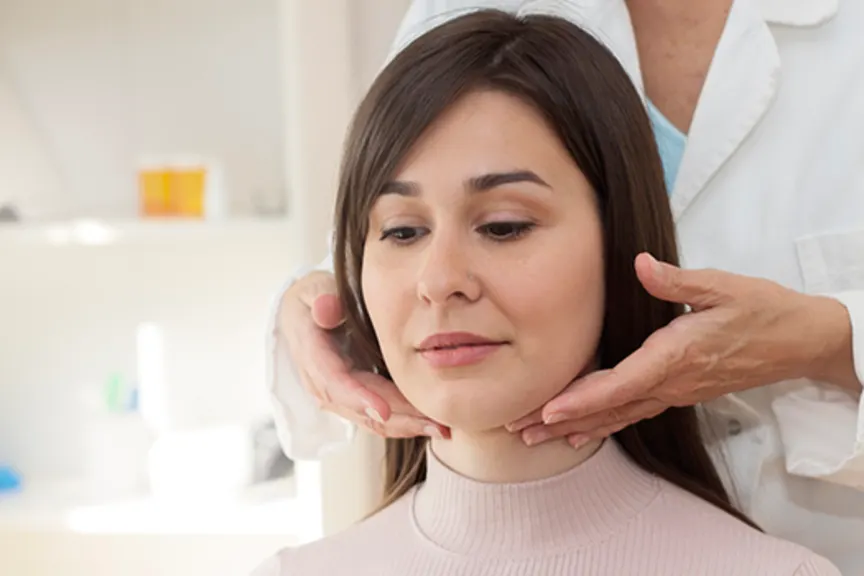How is Hypothyroidism Diagnosed?

Your thyroid glandis a small, butterfly-shaped gland that produces hormones essential for energy and metabolism. It’s estimated that as many as 60 million Americans are hypothyroid, but less than half are currently diagnosed and treated. Thorough and accurate diagnosis of hypothyroidism involves a number of steps that include self-assessment, a medical history, review of your symptoms, clinical examination by a practitioner, blood tests, and, in some cases, imaging tests. Let’s review these steps in the process of diagnosing hypothyroidism.
Self-assessment
Assessing your risk factors for hypothyroidism and recognizing your potential signs and symptoms is often the first step in diagnosis. Here are some important factors that raise the possibility that you may be hypothyroid:
A personal or family history of thyroid or autoimmune disease
A lump or enlargement in your neck
Unexplained symptoms such as fatigue, weight gain, mood changes, orhair loss, among others
Being in a period of hormonal transition, such as pregnancy, postpartum,perimenopause, or postmenopausal
Note that hypothyroidism is not something that is routinely included as part of an annual physical or standard blood tests, so if you suspect that you may be hypothyroid, you should see your practitioner to specifically request a comprehensive thyroid evaluation.
A tip:Some HMOs and health insurance programs will schedule a longer appointment for an annual physical than for other medical checkups. You may want to set aside one of these longer appointments for your comprehensive thyroid evaluation.
Medical history
At your visit, your practitioner should review your medical history, with special attention to:
A family history of thyroid disease, especially in first-degree relatives (parents, siblings, children) and female relatives
A family or personal history of autoimmune disease
Any past episodes of thyroid disease that you may have experienced, such as a temporary thyroiditis or postpartum thyroiditis
Any past surgery or radioactive iodine (RAI) treatment of your thyroid
Any history of trauma to your neck
Any medications you are taking, with particular notice of those known to cause hypothyroidism, such as lithium and amiodarone
Clinical examination
Your practitioner should conduct a thorough clinical thyroid examination, which should include the following evaluations:
Using a stethoscope to listen to the blood flow in your thyroid. The practitioner will be listening for increased blood flow, known as bruit, that is common in hypothyroidism.
Feeling your neck for enlargement (goiter) and nodules; both can be signs of hypothyroidism.
Checking your reflexes. Typically, the doctor will use a small rubber mallet to see if your reflexes are slowed, common in hypothyroidism.
Checking your heart rate. A low heart rate can point to hypothyroidism.
Checking your blood pressure. Low blood pressure can be a sign of hypothyroidism.
Checking your heart rate, rhythm and blood pressure.
Checking your weight to look for weight gain since your last visit, as this can be a sign of hypothyroidism.
Evaluating your hair. Thinning hair and loss of hair from the outer edge of the eyebrows are both signs of hypothyroidism.
Checking for swelling. Your practitioner should examine your face, hands, and feet for edema — swelling and puffiness — a common thyroid sign.
审查的症状
Your practitioner should review your key symptoms with you. It may be helpful to bring a one-page summary list of your most problematic symptoms. Even better: Consider sending the summary list ahead of your appointment, in case the practitioner has time to review it in advance.
A special tip for women:Unfortunately, because common hypothyroidism symptoms such as fatigue, weight gain, and mood changes are sometimes due to lifestyle, mental health issues, hormonal changes, or other causes, some doctors do not think to test for hypothyroidism. It can be helpful to numerically quantify your symptoms as much as possible and present them in a factual, unemotional way, so they are taken more seriously by your practitioner. For example:
Instead of “I’m getting so fat!” say “I’m gaining 2 pounds a week despite a healthy diet or 1200 calories a day and working out at the gym four hours a week.”
Instead of “I’m so tired all the time!” say “I’m sleeping eight to nine hours per night, but I still need a nap before I can make dinner every night, and I sleep 12 or more hours per night on the weekend just to function.”
Quantifying your symptoms helps your practitioner “hear” the symptoms as data inputs, rather than as complaints due to emotional symptoms.
Blood tests
According to the American Thyroid Association, and the American Association of Clinical Endocrinologists, a number of blood tests can factor into the diagnosis of hypothyroidism.
促甲状腺激素(TSH):The TSH test measures a pituitary hormone that acts as a messenger to tell the thyroid gland to produce more thyroid hormone. So TSH levels go up when you are hypothyroid, as the pituitary is trying to trigger an increase in thyroid hormone production. The reference range for TSH typically is from .50 to 4.5.
It is important for you to know the actual number, and not just that you are "normal" or "in the reference range," because there is disagreement as to what constitutes a normal TSH. Some doctors consider the top cutoff to be 2.50, and will treat at levels above 2.5 but still within the reference range. Other doctors only treat after TSH exceeds the 4.5 level. A subset of practitioners believes that levels up to 10.0 are "subclinical" and don't warrant treatment.
Free Thyroxine (Free T4) Test:Free T4 measures the storage hormone, thyroxine, which is converted into triiodothyronine (T3) in order to be used by the body. The reference range for free T4 is 0.8 - 1.8 ng/dL. Free T4 levels that are below the reference range are indicative of hypothyroidism.
Free Triiodothyronine (Free T3) Test:Free T3 measures the available amount of circulating triiodothyronine — the active thyroid hormone. The reference range for free T3 is 2.3- 4.2 pg/mL. Free T3 levels that are below the reference range are indicative of hypothyroidism. Some practitioners feel that even when the TSH level is within the reference range, free T3 levels that fall in the lower end of the reference range are also indicative of mild or subclinical hypothyroidism.
Reverse T3 (RT3) Test:Reverse T3 is an inactive form of T3 that is produced when the body is under various types of stress. This test is considered controversial by mainstream endocrinologists and physicians but is routinely used by integrative practitioners and experts in hormone balance. The RT3 reference range at many laboratories is 10-24 ng/dL. Levels above 15 are considered to be a sign that too much of the circulating T3 may be this inactive “reverse” form, which can cause hypothyroidism and related symptoms at the cellular level.
Thyroid Peroxidase Antibodies (TPOAb) Test:The main cause of hypothyroidism in the U.S. is Hashimoto’sthyroiditis, an autoimmune disease.In Hashimoto’s thyroiditis, antibodies are produced that attack enzymes needed by the thyroid gland to function. In some cases, the antibodies impair or even destroy the thyroid over time and cause it to atrophy. The result of this damage to the thyroid gland is hypothyroidism.
The thyroid peroxidase antibodies (TPOAb) test measures the antibodies found in Hashimoto’s thyroiditis. Many mainstream physicians and endocrinologists do not feel that TPOAb testing is necessary. Other practitioners, however, routinely include TPOAb testing in the initial diagnosis, to specifically determine if you have Hashimoto’s-induced hypothyroidism, and a tendency towards autoimmunity in general.
It’s also important to know that there is a controversy about treating patients who have elevated TPOAb levels along with a TSH level in the reference range. In many cases, if you have elevated antibodies, even if your TSH, free T4, and free T3 levels are within range, you may have hypothyroidism symptoms. Some researchers have found that treatment with thyroid hormone replacement drugs (such as Synthroid, Levoxyl, Nature-throid, or Armour Thyroid) in these patients can not only relieve symptoms, but may also lower antibody levels and prevent progression to worsening and overt hypothyroidism.
Imaging tests
Imaging tests但是,没有必要诊断甲状腺功能减退吗in some cases, they are useful to help identify structural issues with your thyroid or to identify the underlying cause of your underactive thyroid. Your practitioner may order:
A CT scan, known colloquially as a “CAT scan,” which can help to visualize thyroid enlargement or atrophy, irregular shape, and detect larger thyroid nodules
Magnetic resonance imaging (MRI), which can provide information about the shape and size of your thyroid, and identify enlargement or atrophy
Ultrasound of the thyroid, which can detect and evaluate liquid-filled thyroid cysts, solid thyroid nodules, and detect enlargement or atrophy





